By Tina Cardone, Posted March 2, 2015 –
Few
phrases make me cringe the way I do when I hear, “Ours is not to reason why;
just invert and multiply.” A student’s job in math class is to reason, and a
teacher’s job is to help the students see that math makes sense. Understanding
division of fractions is complicated, bringing together many ideas that build
up to a method that makes sense, especially in the tricky case of a fraction
divided by a fraction. Liping Ma
writes about research asking teachers to explain what it means to divide by a
fraction. Most U.S. teachers were startled to find how difficult this was for
them.
What
if we start with the simpler case of a whole number divided by a fraction?
Christopher Danielson
posed the question below (#tmwyk
is his project Talking Math With Your Kids) and asked how we would think it through. I was surprised
by how I arrived at my answer.
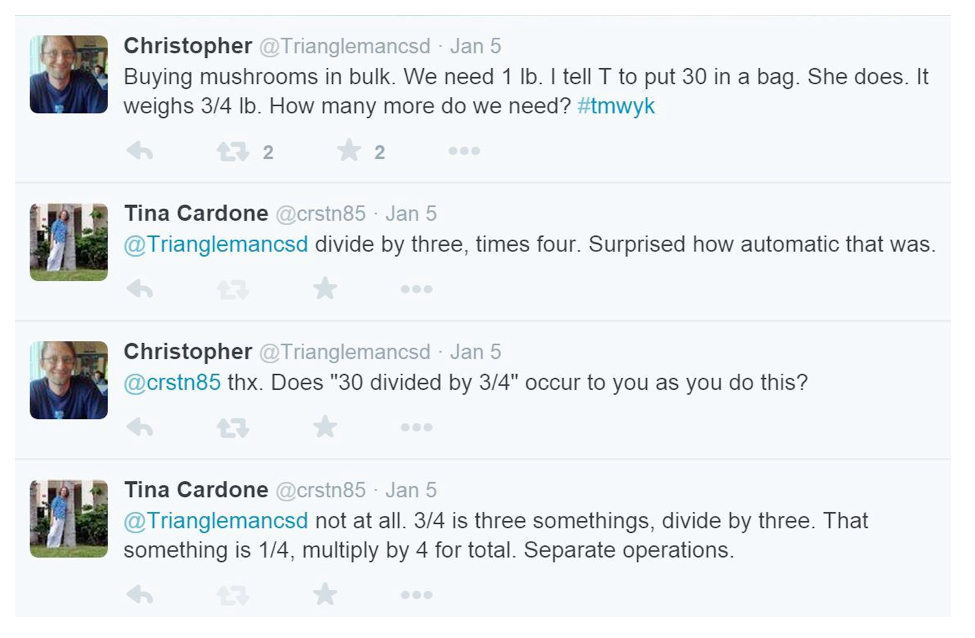
I
was able to use my understanding of fractions to go from unwieldy part (3/4) to
unit fraction (1/4) to whole. I realized later that I was solving for the total
rather than answering the question, “How many more?” There are many different
strategies for this question, some of which include finding how many more
directly without calculating the total. You can check out the conversation
to see other approaches. Max Ray recently made a
presentation on a similar prompt (7 cups of dog food, divided into 2/3 cup
servings). Check out his presentation that includes several examples of student
methods for solving the problem:
Ignite Talk from AMTNJ.
I
was surprised how automatic this process was and that it didn’t require “the”
standard algorithm. I completed all the steps in the standard approach to
dividing by a fraction but I (1) didn’t need to recognize the problem as
requiring division by a fraction, and (2) knew why I was completing each step.
How
many students think this way? I have to admit I don’t think this way when I see
a problem without context. If I saw

I
would multiply 30 by the reciprocal of 3/4. But students could see why we do that if they were encouraged
to take some more time to explore what it means to divide by a fraction.
Division
and multiplication are inverse operations. We can write

for
any fact family. This is how students approach integer division; there’s no
reason not to approach fraction division the same way:
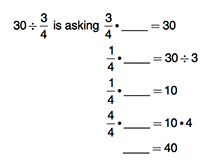
What
steps did we take? First, we divided by the numerator to get a unit fraction.
Then we multiplied by the denominator to get the whole. When students repeat
this process, first in context, then in more general cases, they will recognize
the pattern. When someone recognizes the pattern, celebrate! And share that
this pattern has a name. Dividing by the numerator and multiplying by the
denominator can be completed in one step (multiply by original denominator over
original numerator); this new thing is called the reciprocal. Taking two steps to complete this process is still
efficient, but the idea of the reciprocal becomes important, so students should
be introduced to the term.
The
phrase “multiply by the reciprocal” is preferable to “same, change, flip,” or
any other mnemonic. Reciprocal is a precise term that reminds students why we
are switching the operation. I see many students who use language like “same,
change, flip” without understanding where it comes from. This leads to mistakes
like this one:
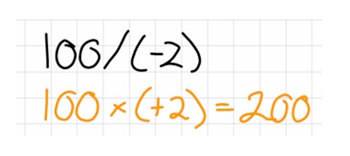
http://mathmistakes.org/?p=328
This
student doesn’t appear to know the difference between “flipping” a fraction and
“flipping” the sign of a number. The overuse of the word opposite can further compound errors because the vocabulary is open
to interpretation.
Once
students have an understanding of dividing a whole number by a fraction, it’s
time to tackle dividing two fractions. The procedure is the same, but there are
a few ways to build intuition. Again, use the phrase
“multiply by the reciprocal,” but only after students understand where this
algorithm comes from.
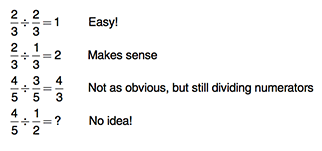
If
the last problem looked like the previous examples, it would be easier. So let’s
rewrite with common denominators:

If
students are asked to solve enough problems in this manner, they will want to
find a shortcut and will look for a pattern. Show
them (or ask them to prove!) why multiplying by the reciprocal works. One way
to show this is in the following way:
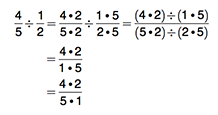
In
this case, students discover that multiplying by the reciprocal is the
equivalent of getting the common denominator and dividing the numerators. This
is not an obvious fact. Students will only reach this realization with repeated
practice, but practice getting common denominators is a great thing for them to
be doing! More important, the student who forgets this generalization can fall
back on an understanding of common denominators, whereas the student who
learned a trick after completing this exercise once (or not at all) will guess
at the rule rather than attempting to reason through the problem.
Tina Cardone, @crstn85, is a high school teacher at
Salem High School in Salem, Massachusetts. She is the author of Nix
the Tricks and blogs about her teaching at DrawingOnMath.blogspot.com.
